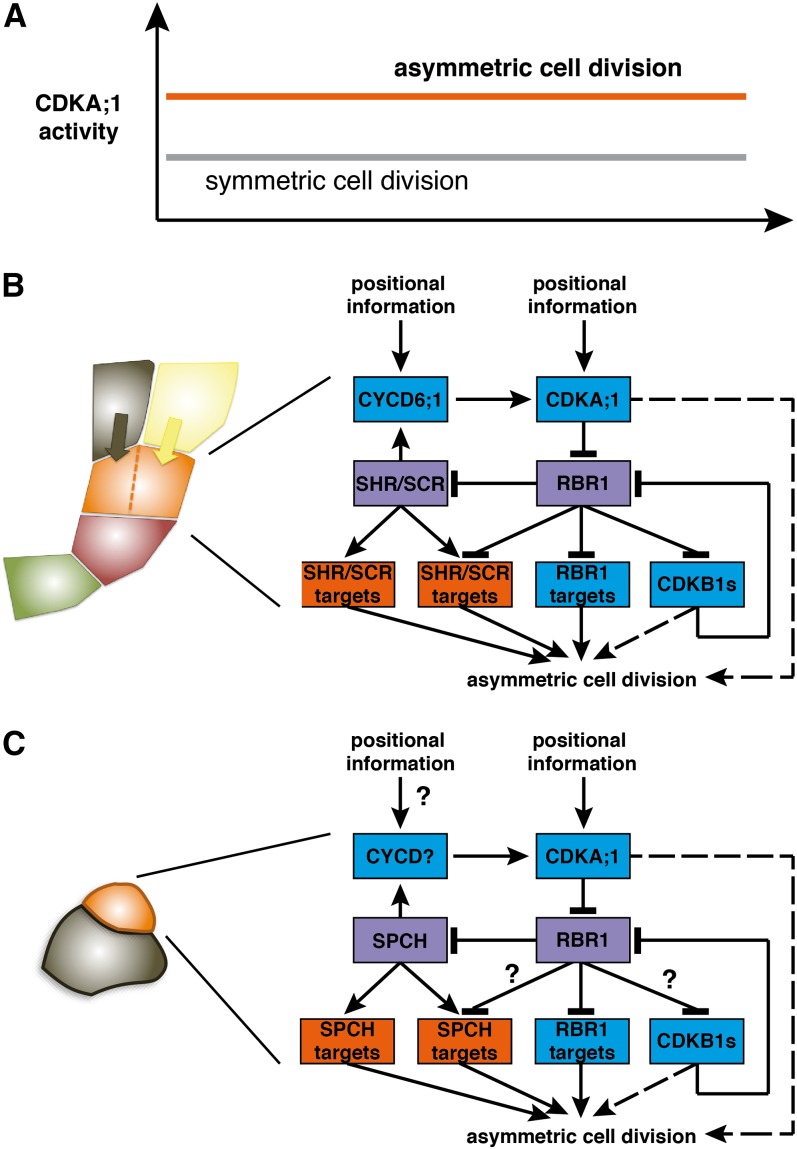Figure 6.
(A) Model of asymmetric cell division in Arabidopsis. Of central importance is RBR1, which inhibits both cell cycle genes, such as MCM5, and cell differentiation genes, such as SCL3. At low levels of CDKA;1 activity (i.e., low levels of RBR1 inactivation), symmetrical cell divisions can occur, but inhibition of cell differentiation genes is only released at high levels of CDKA;1 activity (i.e., high levels of RBR1 inactivation), leading to asymmetric divisions.
(B) High levels of CDK activity in the initial daughter (orange) are directed by developmental cues (e.g., by the position-dependent activation of CYCD6;1 that is also regulated by SCR and SHR). In addition, other positional cues appear to guide CDKA;1 activity to promote the division of the upper-most initial daughter and thus likely involve cues from the already specified endodermis (black) and cortex (yellow) layers. Green shading, quiescent center cell; red, initial. Model of molecular circuitry during asymmetric divisions in the cortex-endodermis initial daughter cell. RBR1 and SHR/SCR (violet boxes) integrate cell differentiation (genes with orange boxes) with cell cycle control (genes in blue boxes). The activation of genes required for asymmetric cell divisions involves double negative-feedback loops, resulting in a feed-forward mechanism that is likely to generate hysteresis. SHR/SCR activate CYCD6;1, which then inactivates their repressor (RBR1). Whether CDKs (i.e., CDKA;1 and CDKB1) also participate directly in the regulation of the symmetric division, for instance, by regulating the spindle orientation, is not clear and is indicated by a hatched line.
(C) Model of formative division during the stomata lineage. The formative division restores the meristemoid cell (orange) and generates a neighboring epidermal cell (black). High levels of CDKA;1 activity in the meristemoid mother cell and/or meristemoid (orange) are required to initiate formative divisions in the stomata lineage. Similar to the root, the major substrate appears to be RBR1. Whereas CDKB1s have a role during the symmetric division of a guard mother cell, it is not clear whether they also participate during formative divisions (question mark). The basic helix-loop-helix transcription factor SPCH is regulated by RBR1. In analogy to the function of SHR and SCR, it seems likely that SPCH directly regulates the expression of cell cycle genes, such as D-type cyclins. However, there is currently no molecular evidence for this (question mark). It is also not clear whether SPCH targets are regulated by RBR1 (question mark). Similar to the root, it is remains to be seen whether CDKs regulate other aspects of asymmetric divisions (e.g., the polar localization of cell fate determinants) (hatched line).

